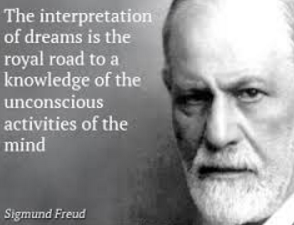 Sigmund Freud, an Austrian psychologist, was keen on neurological psychology. His study into the Interpretation of Dreams brought him to the conclusion that our dreams are essentially wishes we want to fulfil. Freud believed that what we dream is what is subconsciously of particular importance to us. I chose to read further into his findings, as from a young age I have always been fascinated with dreams.
Sigmund Freud, an Austrian psychologist, was keen on neurological psychology. His study into the Interpretation of Dreams brought him to the conclusion that our dreams are essentially wishes we want to fulfil. Freud believed that what we dream is what is subconsciously of particular importance to us. I chose to read further into his findings, as from a young age I have always been fascinated with dreams.
Freud believed that in our early years, our dreams expressed our infantile wishes. One example of this is our dreams about the death of a same-sex parent. As shocking as this sounds, this is normal for babies; as they see their same-sex parent as a threat. Freud believed that dreams allow us to express other wishes and desires, such as:
 The desire for a loved one’s presence, even though they are deceased
The desire for a loved one’s presence, even though they are deceased- The desire to return to childhood
- The desire for impossible revenge
- The desire for sleep as an escape
Freud did, however, argue that symbols within dreams had the same significance for everyone. Which surely, cannot be right? Everyone is different, and we all have different experiences and ways of expressing things. So the same symbol within two completely different contexts must have different meanings. There are also arguments that his work is too generalised, there are no specific findings.
He does say that these symbols that appear a lot, may hold the same meanings, but depending on the context of the dream and the person interpreting it the conclusions may be different. The main symbol Freud analysed is the sexual symbol. These symbols are what is keeping the technique of interpreting dreams going. It is useful in many psychiatric situations to analyse dreams as the patients “dream-thought” are, a lot of the time, thoughts they have pushed to the back of their minds.
It is interesting to know that many of the dreams Freud analysed were actually his own. In order to make it as accurate as possible, Freud wrote down these dreams as soon as he woke up. On one occasion, he could even see links from the events in the day before within his dream. It became apparent that people in Freud’s everyday life were also those appearing in his dreams. As a doctor, a lot of his dreams turned out to be linked with medical mistakes he had made, bringing him to the conclusion that he was subconsciously trying to get rid of his guilt about these incidents, through his dreams.
is interesting to know that many of the dreams Freud analysed were actually his own. In order to make it as accurate as possible, Freud wrote down these dreams as soon as he woke up. On one occasion, he could even see links from the events in the day before within his dream. It became apparent that people in Freud’s everyday life were also those appearing in his dreams. As a doctor, a lot of his dreams turned out to be linked with medical mistakes he had made, bringing him to the conclusion that he was subconsciously trying to get rid of his guilt about these incidents, through his dreams.
His overall conclusion was that our dreams are essentially wishes we want to fulfil, as previously mentioned. His theory was that every dream had latent content (including wishes), and manifest (simply the opposite of a wish fulfilment). The latent content of dreams could then only be remembered through free-association (consciously thinking about something at your own free-will).
As a teacher, we should be aware that our dreams may indicate things we may perhaps not have noticed in our everyday life’s. They can also be an indicator of stress or nerves, which we would then obviously have to address. Our dreams will be very different from our pupils. If we ever hear a pupil describing a dream, especially one in which triggers any worries – we should perhaps not look over the fact it was “only a dream”. Something caused that child to dream that dream!
Here’s a video summarising his complete theory:
https://www.youtube.com/watch?v=xBb4qnkclb8


Another great blog post! I had a look into some of Freud’s work on dreams but found some of the terminology quite difficult to understand. Your post has really helped because you have manged to simplify and summarise the key points. Also a great video reference. Thank you 🙂
It was hard to find stuff I understood to start with, but I was so intrigued I kept looking! I’m glad my post helped you. Thanks for your comment!